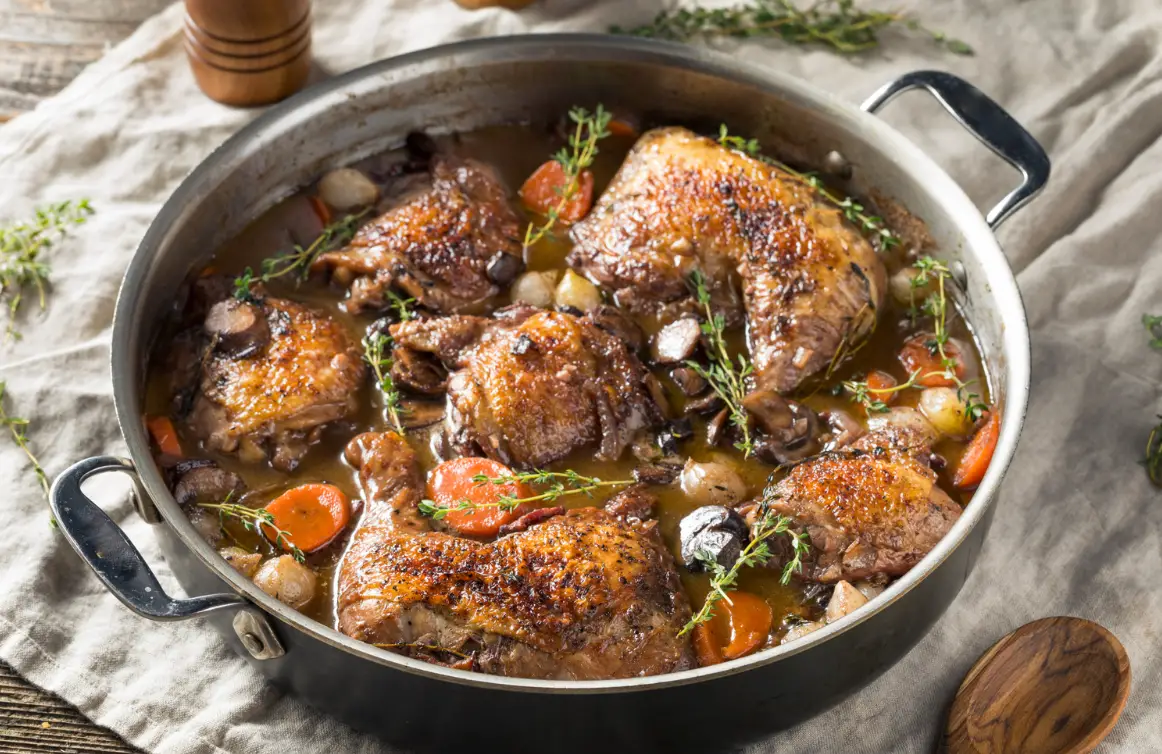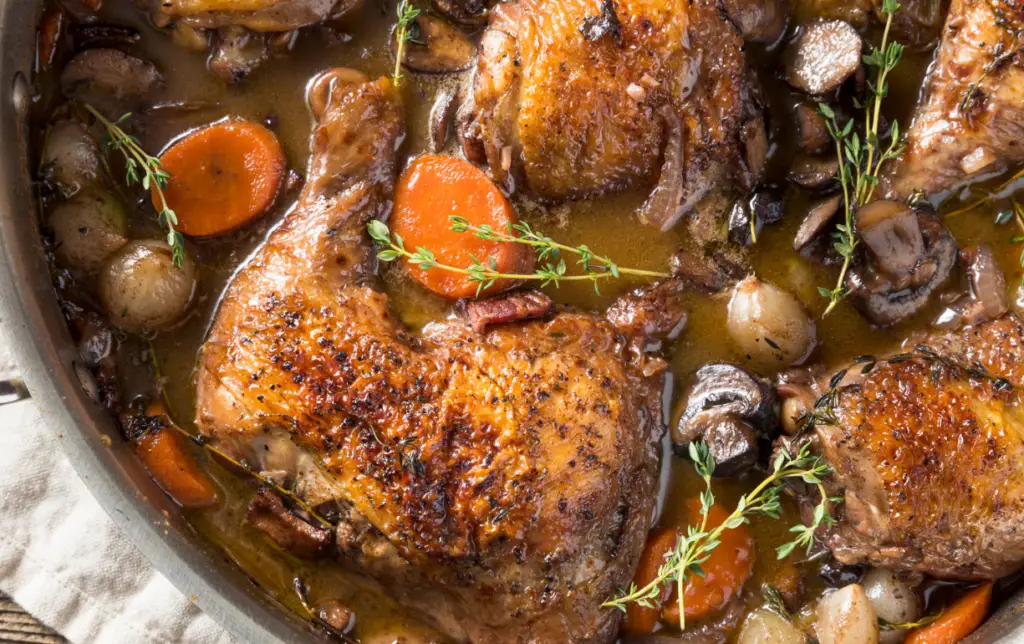French Onion Chicken combines the heartwarming flavors of a classic French soup with the satisfying richness of chicken. This dish, a symphony of caramelized onions and melted cheese atop tender chicken, has become a beloved recipe in kitchens worldwide. In this comprehensive guide, we’ll delve into the origins, cooking techniques, and variations of French Onion Chicken, ensuring that even a novice cook can bring this gourmet delight to their dinner table.
History and Origin of French Onion Chicken
The Roots of French Onion Chicken Soup
The story of French Onion Chicken begins with its ancestor, the iconic French Onion Soup. This soup, a staple in French cuisine, dates back to Roman times. Originally a humble dish, it gained popularity in France during the 18th century. The key to its heartiness lies in the slow caramelization of onions, which are then simmered in a rich broth and topped with a slice of crusty bread and melted cheese.
From Soup to Chicken Dish
The transformation of this soup into a chicken-based dish is a relatively recent culinary innovation. Chefs began experimenting with the soup’s core flavors, seeking to create a more substantial meal that maintained the essence of the original recipe. The result was French Onion Chicken, where the chicken acts as a canvas for the rich, savory flavors of caramelized onions and melted cheese.
Cultural Significance
French Onion Chicken is more than just a fusion of ingredients; it’s a testament to the evolution of culinary traditions. By adapting the flavors of a classic soup to a hearty main course, this dish represents a blend of simplicity and sophistication. It’s a celebration of rustic comfort food with a gourmet twist, making it a favorite in both home kitchens and upscale restaurants.
Key Ingredients and Substitutes
Essential Ingredients for Authentic Flavor
The soul of French Onion Chicken lies in its ingredients. The must-haves include:
- Chicken: Preferably breasts or thighs for their texture and ability to absorb flavors.
- Onions: Yellow onions are ideal for their perfect balance of sweetness and bite.
- Cheese: Gruyere is traditional, but Swiss or Provolone can also be used.
- Broth: A rich beef or chicken broth forms the base of the sauce.
- Herbs and Spices: Thyme, garlic, salt, and pepper are essential for depth and aroma.
Substitutes for Dietary Restrictions
To accommodate various dietary needs, consider these substitutes:
- For a gluten-free version, use gluten-free flour for thickening the sauce.
- Lactose-intolerant individuals can opt for lactose-free cheese or skip it altogether.
- Vegetarians can replace chicken with portobello mushrooms and use vegetable broth.
Quality Ingredients: A Key to Flavor
The choice of ingredients significantly impacts the dish’s flavor. Fresh, high-quality ingredients ensure a richer, more authentic taste.
Step-by-Step Cooking Guide

Preparing the Chicken
- Begin by seasoning the chicken with salt, pepper, and herbs.
- In a skillet, sear the chicken until golden brown. This step is crucial for locking in flavors.
Caramelizing Onions: The Heart of the Dish
- In the same skillet, add sliced onions. Cook them slowly until they turn a deep golden brown, releasing their natural sugars.
Combining Ingredients
- Once the onions are caramelized, add garlic and a splash of broth to deglaze the pan, scraping up any browned bits.
- Return the chicken to the skillet, nestling it among the onions.
- Pour in the remaining broth, ensuring the chicken is partially submerged.
Final Touches
- Top the chicken with slices of cheese.
- Bake in a preheated oven until the cheese is bubbly and golden.
- Garnish with fresh thyme before serving.
Variations of French Onion Chicken
Regional Variations
French Onion Chicken, a dish celebrated for its versatility, sees numerous regional adaptations that reflect local tastes and ingredients. In some parts of France, chefs might add a splash of local wine to the onion mixture, infusing the dish with a unique regional flavor. In other areas, different types of onions, like sweet Vidalia or sharp red onions, are used to alter the dish’s sweetness and intensity. These regional variations not only add a delightful diversity to the recipe but also showcase the adaptability of this classic dish to local preferences.
Modern Twists and Chef’s Special Versions
Contemporary chefs have embraced French Onion Chicken, adding their unique spins that transform this traditional dish into a modern culinary masterpiece. Some innovative versions include the addition of balsamic vinegar for a tangy twist or a topping of crispy fried onions for added texture. Gourmet adaptations might feature a reduction of port or sherry, elevating the dish with a sophisticated depth of flavor. These modern interpretations are a testament to the dish’s enduring popularity and its ability to inspire culinary creativity.
Vegetarian Adaptations
Recognizing the growing demand for vegetarian options, French Onion Chicken can be easily adapted for a meat-free diet without losing its essence. The chicken can be substituted with hearty alternatives like portobello mushrooms, seitan, or tofu, which beautifully absorb the rich flavors of caramelized onions and melted cheese. Vegetable broth can replace the traditional chicken or beef broth, ensuring the dish remains true to its roots while being completely vegetarian. These adaptations not only cater to diverse dietary preferences but also open up new avenues of taste and texture within the realm of vegetarian cuisine.
Explore Versatile Healthy Adapting Thin Chicken Breast Recipes for Every Diet for more ideas on how to adapt French Onion Chicken to various dietary preferences.
Nutritional Information for French Onion Chicken

Macronutrient Breakdown
French Onion Chicken is a dish that offers a balanced macronutrient profile, making it a fulfilling addition to any meal plan. Here’s a breakdown:
- Proteins: The chicken serves as an excellent source of lean protein, essential for muscle repair and growth.
- Fats: The cheese and oil used in cooking contribute to the fat content, providing satiety and flavor. Opting for low-fat cheese can reduce the overall fat content.
- Carbohydrates: Onions, the star ingredient, add a modest amount of carbs. The dish’s carb content can vary depending on any additional ingredients like flour or wine.
Dietary Considerations
- Gluten-Free Options: For those with gluten sensitivities, using gluten-free flour or cornstarch as a thickener makes this dish completely gluten-free without compromising on taste.
- Low-Carb Options: To make a low-carb version, reduce the number of onions or thicken the sauce with a low-carb alternative like xanthan gum.
Health Benefits of Key Ingredients
- Chicken: A great source of lean protein, chicken is vital for muscle building and repair. It’s also rich in vitamins and minerals like B vitamins, which are crucial for energy production.
- Onions: Onions are high in antioxidants, particularly quercetin, which has anti-inflammatory properties. They also contribute to heart health and may have anti-cancer effects.
- Cheese: A good source of calcium, cheese contributes to bone health. It also provides protein and essential fatty acids.
In summary, French Onion Chicken can be a nutritious dish that fits into various dietary preferences. By adjusting ingredients, it can be tailored to meet gluten-free or low-carb requirements, making it a versatile choice for many. For a detailed breakdown of the nutritional content in French Onion Chicken, including calorie count and macronutrients, visit Carb Manager – Home Chef French Onion Chicken.
Pairing with Sides for French Onion Chicken
Recommended Side Dishes
The rich and savory profile of French Onion Chicken pairs well with a variety of side dishes. Here are some top recommendations:
- Mashed Potatoes: Their creamy texture complements the richness of the chicken and helps in balancing the intense flavors of the caramelized onions.
- Green Salad: A fresh green salad with a light vinaigrette dressing offers a crisp, refreshing contrast to the dish, adding a healthy balance.
- Roasted Vegetables: Vegetables like carrots, Brussels sprouts, or asparagus, roasted to perfection, provide a delightful textural contrast and nutritional boost.
- Grain Pilaf: A pilaf made from quinoa, rice, or barley can be a great addition, as it absorbs the flavors of the dish while adding its own subtle taste and texture.
- Garlic Bread: For those who enjoy a heartier accompaniment, garlic bread is an excellent choice, perfect for soaking up the delicious sauce.
Understand the impact of various side dishes on the overall nutritional profile of your meal with French Onion Chicken at Eat This Much – French Onion Chicken Nutrition Facts.
Balancing Flavors
When pairing sides with French Onion Chicken, the key is to balance the richness of the main dish. Lighter sides like salads or steamed vegetables can offset the heartiness of the chicken, providing a well-rounded meal experience. Similarly, choosing sides that can absorb or complement the flavors of the sauce, like mashed potatoes or grain pilaf, ensures that every element of the meal harmonizes without overpowering the others. The goal is to enhance the dining experience by offering a variety of textures and flavors that complement the main dish.
Common Mistakes and Troubleshooting
Addressing Common Cooking Errors
- Overcooking the Chicken: One of the most common mistakes is overcooking the chicken, making it dry and tough. To avoid this, cook the chicken just until it’s no longer pink inside, and let it finish cooking in the sauce.
- Rushing the Caramelization: Caramelizing onions takes time and patience. Rushing this process can lead to undercooked or unevenly browned onions, which affects the overall flavor.
- Uneven Seasoning: Another error is uneven seasoning, either too bland or too salty. Always taste as you go and adjust the seasoning gradually.
Tips for Perfect Caramelization
- Low and Slow: Cook the onions on a low to medium heat. This slow process allows the natural sugars in the onions to caramelize without burning.
- Regular Stirring: Stir the onions regularly to ensure even cooking and to prevent them from sticking to the bottom of the pan.
- Adding a Pinch of Sugar: A small amount of sugar can help in the caramelization process, enhancing the natural sweetness of the onions.
Adjusting Flavors and Consistency
- Balancing Saltiness: If the dish is too salty, add a splash of water or unsalted broth. You can also add more caramelized onions or a bit of cream to mellow out the saltiness.
- Thickening the Sauce: If the sauce is too thin, let it simmer to reduce and thicken. Alternatively, a slurry of cornstarch and water can be added for quick thickening.
- Enhancing Flavor: If the dish tastes flat, a pinch of salt, a squeeze of lemon juice, or a dash of Worcestershire sauce can enhance the overall flavor profile.
By being mindful of these common mistakes and knowing how to troubleshoot them, you can ensure that your French Onion Chicken turns out perfectly flavorful and satisfying every time. For more tips on cooking chicken to perfection, check out Master the Art of Moist and Flavorful Chicken Every Time.
Advanced Tips and Chef’s Secrets
Professional Cooking Techniques
- Layering Flavors: Build flavors by cooking each ingredient at its optimal time. For instance, add garlic after onions are caramelized to prevent burning.
- Deglazing: Use wine or broth to deglaze the pan after cooking the chicken. This step extracts the flavorful bits stuck to the pan.
Enhancing Flavors
- Herb Infusion: Add fresh herbs like thyme or rosemary during the last few minutes of cooking to infuse the dish with aromatic flavors.
- Cheese Choice: Experiment with different cheeses like aged Gouda or Emmental for a unique flavor profile.
Presentation and Garnishing Tips
- Plating: Serve on a warm plate to keep the dish hot.
- Garnishing: Use fresh herbs or a sprinkle of finely chopped parsley for color and freshness.
FAQs
How Can I Make French Onion Chicken in a Slow Cooker?
Slow cookers are great for tenderizing chicken. First, caramelize the onions on the stove, then transfer them with the chicken and broth to the slow cooker. Cook on low for 6-8 hours.
Can I Use White Onions Instead of Yellow?
Yes, white onions can be used, but they have a sharper, less sweet flavor compared to yellow onions.
What Are Some Quick Sides to Serve with This Dish?
Quick sides include a green salad, garlic bread, or sautéed green beans. They add freshness and balance to the meal.
How Long Can I Store Leftovers?
Store leftovers in an airtight container in the refrigerator for up to 3 days. Reheat in the oven or microwave.
Can I Freeze French Onion Chicken?
Yes, it freezes well. Cool the dish completely, then store in a freezer-safe container for up to 3 months. Thaw in the refrigerator before reheating.
Conclusion
French Onion Chicken is a delightful dish that combines the comfort of caramelized onions and melted cheese with the heartiness of chicken. By following this guide, you can create a gourmet meal that’s sure to impress. Remember to use fresh ingredients, be patient with caramelization, and don’t be afraid to experiment with variations. Bon appétit!
